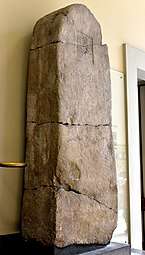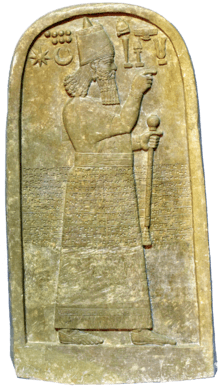Shammuramat
Sammurāmat or Sammuramāt was a regent of Assyria between 811 and 808 BC.[1]
| Shammuramat | |
|---|---|
| Queen of Assyria | |
 Stele of the Assyrian queen Shammuramat, from Assur, Iraq, c. 809 BCE. Pergamon Museum | |
| Regent of the Neo-Assyrian Empire | |
| Reign | 811 BC – 808 BC or 809 BC - 792 BC |
| Predecessor | Shamshi-Adad V |
| Successor | Adad-nirari III |
| Spouse | Shamshi-Adad V |
| Issue | Adad-nirari III |
Etymology of her name
Sammu-ramāt's name is spelled MÍsa-am-mu-ra-mat in Assyrian sources. It was rendered as Σεμιραμις or Σεμυραμις by Diodorus Siculus (II 4.6), who claimed that the name meant "dove" in the "Syrian" (probably Assyrian) language, which would indicate a derivation from the Akkadian word summatu, or even summu. Rabbinic sages understood her name as šmy rʿm, "thunder of heaven". The modern scholar M. Weinfeld suggested a Phoenician background (šmm rmm, "high heavens"). Jamie Novotny has pointed out that her name could have either a West-Semitic or Akkadian structural background, with the former archetype being DN-rāmu/rāmat ("DN is exalted") and the latter DN-ramāt ("DN is beloved"). In both cases, the first part of the name should be considered as theophoric. Should it be West-Semitic, this first element may have been šammu (as W-Semitic /š/ was rendered as /s/ in Neo-Assyrian), should it be Neo-Assyrian sammu could be a variant of the deity dSa(-a-)mu (meaning "red").[2]
Life
Shammuramat was a wife of King Shamshi-Adad V and after he died in 811 BC, she ruled the Neo-Assyrian Empire as its regent for five years until her son Adad-nirari III came of age.[1] She ruled at a time of political uncertainty, which is one of the possible explanations for why Assyrians may have accepted her rule (as normally a woman as ruler would have been unthinkable). In the city of Ashur, she had an obelisk built and inscribed, which read:
Stele of Sammuramat, queen of Shamshi-Adad, King of the Universe, King of Assyria, Mother of Adad Nirari, King of the Universe, King of Assyria, Daughter-in-Law of Shalmaneser, King of the Four Regions of the World.[3]
Her son was King Adad-nirari III and her grandson was King Shalmaneser IV.[4]
Monuments
Shammuramat's stela (memorial stone) has been found at Assur, while an inscription at Nimrud indicates that she was dominant there after the death of her husband and before the rule of her son.
Semiramis
The legendary Semiramis is usually considered a purely mythical figure; however, there is evidence in Assyrian records suggesting that she may, in fact, be a Greek reflection of Shammuramat. This identification is disputed. Another possibility is that she is given that title after death to reflect similarities with an earlier Sumerian deity.[1] It has been speculated that ruling successfully as a woman may have made the Assyrians regard her with particular reverence, and that the achievements of her reign (including stabilizing and strengthening the empire after a destructive civil war) were retold over the generations until she was turned into a mythical figure.[3] Georges Roux speculated that the later Greek- and Iranian- (Persian and Median) flavoured myths surrounding Semiramis stem from successful campaigns she waged against these peoples, and the novelty of a woman ruling such an empire.[5]
References
- "Sammu-ramat (queen of Assyria)". Britannica Online Encyclopedia. Retrieved 2013-01-04.
- Novotny, Jamie (2004). Baker, Heather D. (ed.). Sammu-rāmat or Sammu-ramāt. Prosopography of the Neo-Assyrian Empire 3/1. Helsinki: The Neo-Assyrian Text Corpus Project. pp. 1083–1084. ISBN 951-45-9056-2.
- J. Mark, Joshua (2014-09-16). "Sammu-Ramat and Semiramis: The Inspiration and the Myth". Ancient History Encyclopedia. Retrieved 2016-04-13.
- Georges Roux: Ancient Iraq, Penguin Books, London 1992, ISBN 0-14-012523-X, page 302.
- Georges Roux - Ancient Iraq
